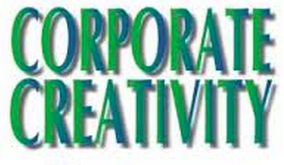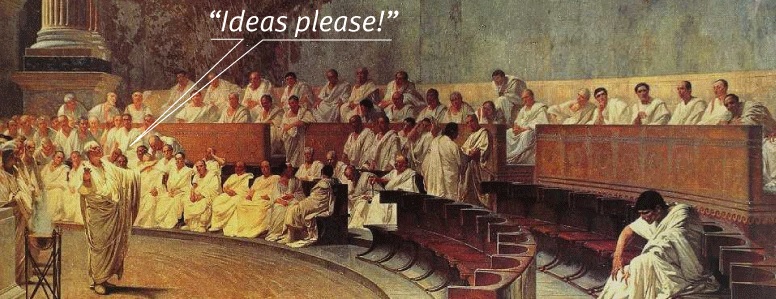
Raising firm’s competitiveness is on everyone’s mind: policy makers are looking for ways to create better conditions for firms while senior executives are looking for ways to beat competition. Some believe that lowering labor costs ought to boost competitiveness; others believe that raising trade barriers is the answer. In this post, I want to show that corporate creativity, a form of innovation where employees are asked for new ideas, may play a significant role in improving any firm’s competitiveness.

I/ Setting up your organization for corporate creativity
Corporate creativity starts out with a CEO-posted question. In order to boost participation and get as many ideas as possible, the question ought to be general enough to be answered by everybody in the firm. Once question is posted, the entire company is aligned to produce and implement new ideas. A team of idea collectors is formed, so that there’s at least one idea collector on every site in the firm. Everybody in the company is involved in some way in new ideas: individual contributors (IC) are evaluated by the number of ideas they suggest on a yearly basis, managers, who are formulating the CEO’s intention of capturing new ideas, are evaluated by the number of ideas they are able to foster in their teams, Business Units (BU) are ranked according to the number ideas they have implemented.
II/ Making corporate creativity happen
Meanwhile, idea collectors scan their respective site for new ideas: they’re setting up meetings, conference calls and invite co-workers out for lunch in order to chase down new ideas. They’re also in charge of managing the process of assessing collected ideas. Contrary to popular belief, most relevant assessment is not provided by a select group of top managers; relevant assessment is provided by people on the ground that have operational knowledge related to the idea to be assessed. In other words, idea collectors ought to form groups of evaluators composed of the idea submitter’s colleagues and pairs. Ideas typically collected are small, concrete and operational ideas. As Michael Porter noted in Competitive Advantage this kind of innovation “is often the cumulation of many small improvements rather than major breakthroughs”. Once ideas are assessed, idea collectors ensure that they are implemented. Finally, idea collectors take part in evaluated the ideas system on a yearly basis. That’s a general framework for setting up a corporate idea system.
III/ American Airlines’ example
American Airlines provides a good example of a successful corporate creativity system. Robert Crandall, CEO ofAmerican Airlines, launched his corporate creativity program, called “IdeAAs in Action” in 1989. Here’s his inaugural speech to employees:
“I’m pleased to announce the beginning of a new program that we hope will produce big changes at American Airlines. The program I’m talking about is designed to use your creativity, your knowledge, and your ideas. As you all know, to remain competitive and profitable in this ever-changing business, we have simply got to find new ways to control expenses and generate revenues… we want you to tell us what those better ways are. We will listen, we will respond, and we will provide awards.”
IV/ Ask S.M.A.R.T questions
Crandall went on to ask questions that were S.M.A.R.T, in the sense of Specific, Measurable, Actionable, Relevant, Time-bound. In addition, in order to boost participation and get as many ideas as possible, the question was general enough to involve everybody in the firm and specific enough to get concrete answers. His question was: “How to save 1 dollar per employee per day?” This question concerned the entire workforce, including pilots, stewards, sales people, marketing personnel, mechanics and others. Everyone came up with small ideas of small savings. In fact, about 400 ideas were pouring in every single day. A team of idea collectors, called IdeAA Representatives, was formed. They were Full Time Employees (FTEs) involved in various parts of the business and had agreed to take the challenge of collecting ideas from their pairs. There was one IdeAA Representative on every site; approximately one IdeAA Representative for every 50 employees. Each collected idea was assessed in one week by a team on the ground that had relevant operational knowledge to assess submitted idea. The assessment of ideas was done in two weeks and any idea which hadn’t been assessed in 150 days was sent to the CEO, Robert Crandall, for assessment. The fact that the firm was aligned to support corporate creativity and that the CEO backed up the corporate creativity program at every phase of the process turned out critical to its success.
V/ corporate creativity: reaping the benefits
And successful, it was. Savings added up exponentially. By 1994, only 5 years after the program was launched, the corporate creativity program had helped save $52 million. This money was used to buy a new airplane, named “Pride of American Airlines”. It stood to symbolize American Airlines’ corporate creativity.
What are your corporate creativity success stories?
Further readings
· For an in-depth presentation of American Airlines’ corporate creativity program, refer to Alan Robinson, Sam Stern, Corporate creativity, chapter 6 “Alignment, the first essential element to corporate creativity”.
· For a discussion on how corporate creativity and learning can lead to cost advantage, refer to Michael Porter,Competitive Advantage, chapter 3 “Cost Advantage”
· For a summary of Alan Robinson and Stern’s Corporate creativity, refer to this article.
· For a clarification on the meaning of corporate creativity and how it differs for creativity, refer to this post.
· On the importance of creativity for CEOs, refer to IBM’s 2010 Global CEO Study, where creativity is selected as most crucial factor for future success.
· For an in-depth video on how to create a creative corporate culture, please refer here.
· For an in-depth study of corporate creativity programs, please refer to Innov’Acteurs. This site is in French.
[…] Pour une description de comment on peut arriver à aligner toute une entreprise autour de l’enjeu de l’innovation, veuillez-vous référer au cas d’American Airlines que j’évoque ici […]